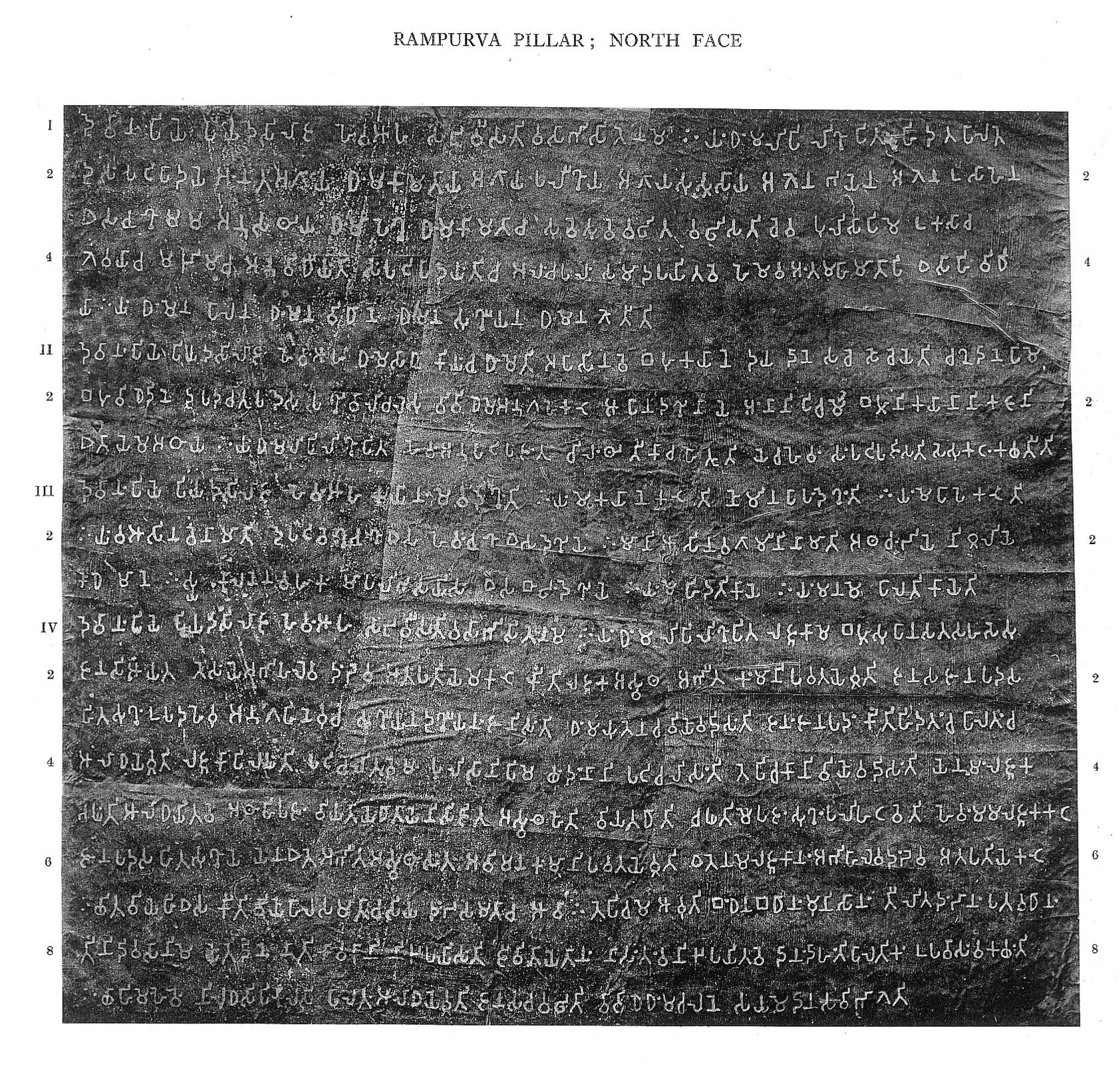Rampurva bull capital side.jpg on:
[Wikipedia]
[Google]
[Amazon]
The Rampurva capitals are the
 The lion pillar is inscribed with the Major Pillar Edicts of the Edicts of Ashoka, Pillar Edicts I, II, III, IV, V, VI.''Buddhist architecture, Huu Phuoc Le, Grafikol, 201
The lion pillar is inscribed with the Major Pillar Edicts of the Edicts of Ashoka, Pillar Edicts I, II, III, IV, V, VI.''Buddhist architecture, Huu Phuoc Le, Grafikol, 201
p.36-40
/ref>
/ref> The bull is without inscriptions, presumably because its twin pillar, the Rampurava lion pillar already had them and therefore there was no need to repeat. It is thought that the bull symbol is not related to the bull Nandi (bull), Nandi of Hinduism, as Ashoka was quite eclectic in his choice of animals for his pillars anyway: lions, elephants, camels, geese, and horses are known.
File:Rampurva Pillar excavation 1877.jpg, Rampurva pillar excavation 1877.
File:Rampurva pillars.jpg, Remains of the pillars today.
File:Original Rampurva bull at Rashtrapati Bhavan, New delhi, India.jpg, Original Rampurva bull up the stairs of Rashtrapati Bhavan, New Delhi.
capitals
Capital may refer to:
Common uses
* Capital city, a municipality of primary status
** List of national capital cities
* Capital letter, an upper-case letter Economics and social sciences
* Capital (economics), the durable produced goods used f ...
of a pair of Ashoka Pillars
The pillars of Ashoka are a series of monolithic columns dispersed throughout the Indian subcontinent, erected or at least inscribed with edicts by the Mauryan Emperor Ashoka during his reign from c. 268 to 232 BCE. Ashoka used the expr ...
discovered in by A. C. L. Carlleyle. The archaeological site is called Rampurva, and is located in the West Champaran district of the Indian state of Bihar, situated very close to the border with Nepal. The lion capital is now in the Indian Museum
The Indian Museum in Central Kolkata, West Bengal, India, also referred to as the Imperial Museum at Calcutta in colonial-era texts, is the ninth oldest museum in the world, the oldest and largest museum in India as well as in Asia. It has rare ...
in Kolkota, while the bull capital is located at the center of the porch of the Rashtrapati Bhavan, the Indian Presidential Palace.
Buddhist significance
Waddell Waddell may refer to:
Places
* Waddell, Arizona
** New Waddell Dam, on the Agua Fria River
* Waddell Barnes Botanical Gardens, Macon, Georgia
* Waddell Creek, a stream in California
* E. E. Waddell Language Academy, Charlotte, North Carolina
* ...
in 1896 suggested that the death or parinirvana of Gautama Buddha was in the region of Rampurva: "I believe that Kusīnagara, where the Buddha died may be ultimately found to the North of Bettiah, and in the line of the Açōka pillars which lead hither from Patna (Pāțaliputra)." Modern scholarship, based on archaeological evidence, believes that the Buddha died in Kushinagar (Uttar Pradesh).
Rampurava lion capital
 The lion pillar is inscribed with the Major Pillar Edicts of the Edicts of Ashoka, Pillar Edicts I, II, III, IV, V, VI.''Buddhist architecture, Huu Phuoc Le, Grafikol, 201
The lion pillar is inscribed with the Major Pillar Edicts of the Edicts of Ashoka, Pillar Edicts I, II, III, IV, V, VI.''Buddhist architecture, Huu Phuoc Le, Grafikol, 201p.36-40
/ref>
Rampurva bull capital
The Rampurva bull capital is noted as one of the seven remaining animalcapitals
Capital may refer to:
Common uses
* Capital city, a municipality of primary status
** List of national capital cities
* Capital letter, an upper-case letter Economics and social sciences
* Capital (economics), the durable produced goods used f ...
from the Pillars of Ashoka. It is composed of a lotiform base, with an abacus decorated with floral designs, and the realistic depiction of a zebu bull.
The abacus in particular displays a strong influence of Greek art: it is composed of honeysuckles
Honeysuckles are arching shrubs or twining vines in the genus ''Lonicera'' () of the family Caprifoliaceae, native to northern latitudes in North America and Eurasia. Approximately 180 species of honeysuckle have been identified in both conti ...
alternated with stylized palmettes and small rosettes. A similar kind of capital can be seen at the basis of the Sankassa elephant capital. A similar frieze is also visible on the Diamond throne
The Vajrasana (; ''diamond throne''), or Enlightenment Throne of the Buddha, is an ancient stone slab located under the Bodhi tree, directly beside the Mahabodhi Temple at Bodh Gaya. The slab is thought to have been placed at Bodhgayā by emp ...
built by Ashoka at Bodh Gaya
Bodh Gaya is a religious site and place of pilgrimage associated with the Mahabodhi Temple Complex in Gaya district in the Indian state of Bihar. It is famous as it is the place where Gautama Buddha is said to have attained Enlightenment ( pi, ...
. These design likely originated in Greek and Near-Eastern arts."Buddhist Architecture" by Huu Phuoc Le,
Grafikol, 2010, p.4/ref> The bull is without inscriptions, presumably because its twin pillar, the Rampurava lion pillar already had them and therefore there was no need to repeat. It is thought that the bull symbol is not related to the bull Nandi (bull), Nandi of Hinduism, as Ashoka was quite eclectic in his choice of animals for his pillars anyway: lions, elephants, camels, geese, and horses are known.
See also
* Pillars of Ashoka * Edicts of Ashoka * Early Indian epigraphyReferences
{{reflist Monumental columns in India Indian inscriptions History of Bihar Mauryan art Archaeological sites in Bihar Sculptures from Bihar